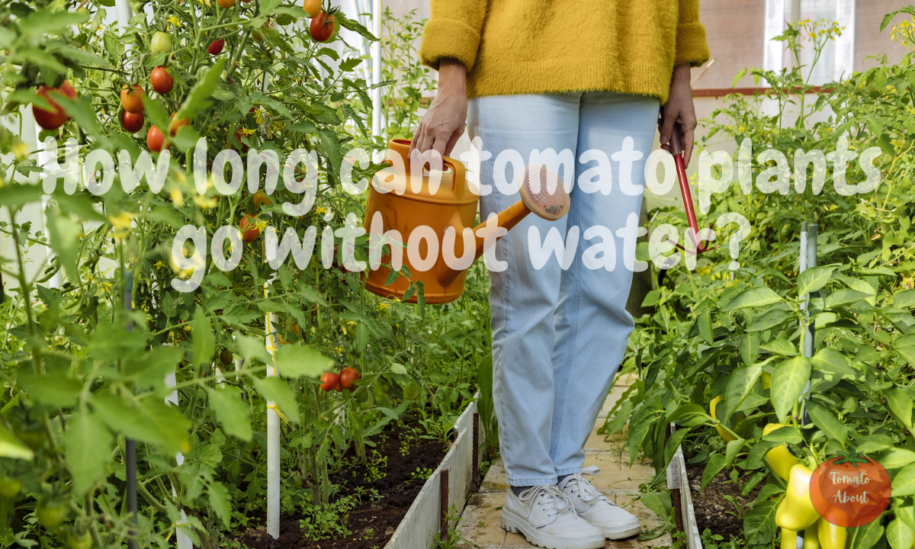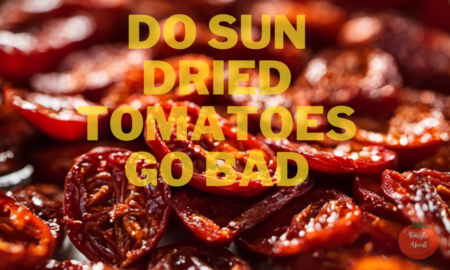It happens to all gardeners – life gets crazy busy and your vegetable plot gets neglected. The weeds take over, pests invade unchecked, and your thirsty tomato plants get missed when it’s time to water.
We all have stretches when gardening falls by the wayside. But when it comes to tomatoes, inconsistent watering can quickly take its toll. Lack of moisture at critical growth stages leads to stunted plants, struggling fruits, and disappointing harvests.
So how long can your precious tomato crop really survive without attention if your watering duties slide? What are the signs that your plants are in distress? And what can repeated moisture stress do to your tomatoes in both the short and long term?
Let’s explore exactly how long tomato plants can go without water, the impacts of underwatering, and how to recover your thirsty tomatoes when you’ve accidentally let the soil go bone dry.
So, How long can tomato plants go without water?
Generally, Tomato plants need watering every 5-7 days. Going longer than that without watering can severely stress the plant, causing wilting, poor growth, and low yields. It’s best not to let the soil dry out completely for extended periods
How Often Should You Water Tomato Plants?
Before looking at how long tomatoes can go without water, it helps to understand their normal water needs. Generally, tomato plants need around 1-2 inches of water per week. This keeps the soil evenly moist but not saturated.
Ideally, you should water tomato plants deeply around 2 times per week during the growing season. Check the soil moisture daily by probing the top few inches, and water when it feels dry. For containers, you may need to water more frequently depending on temperature and exposure.
Tune in to your specific environment and plant’s needs. Increase watering during hot, dry stretches. Back off during rainy spells or if you notice standing water. Finding the right rhythm is key for avoiding both under and overwatering.
How Long Can Tomato Plants Survive Without Water?
Now, onto the pressing question – how long could tomatoes go without water if you slack on your gardening duties(I wrote a detailed article on amazing gardening hacks for your tomato garden)? The answer depends on factors like weather, soil, and plant maturity.
The exact time tomatoes can survive without water depends on several factors:
- Container vs in-ground – Container plants dry out faster and may only last 3-7 days without water. In-ground plants have more soil moisture to draw from and may survive 7-10 days.
- Sun exposure – Tomatoes in full sun will use up their moisture reserves quicker than shaded plants. Expect to water more frequently, around every 2-4 days.
- Soil type – Sandy soils drain faster while soils with clay retain more moisture. Clay-heavy garden beds may go 10-14 days whereas sandy soils dry out in 2 days.
- Plant maturity – Younger tomato transplants are more vulnerable and may only withstand 2-4 days without water before permanent damage. Established plants can go 1-2 weeks.
- Weather conditions – Hot, dry, and windy conditions accelerate moisture evaporation from soil and plants. This cuts survival time by several days versus cooler, calm weather.
Generally,
- Young seedlings may survive only 2-4 days without water. Their small size makes them very vulnerable to drying out.
- Established tomato plants can go 1-2 weeks without water and still recover.
- In very dry, hot, or windy conditions, 5-7 days without water may severely damage plants.
- If blossoms and fruits are developing, even a few days without water can have impacts.
While established tomato plants are somewhat drought-hardy thanks to their deep roots, allowing repeated water stress takes a toll. Extended deprivation of over 2 weeks can be deadly.
Signs Your Tomato Plants Need Water
Don’t let your tomatoes get overly thirsty before taking action. Watch for these cues that your plants urgently need hydration:
- Wilting or drooping leaves – Early sign of water stress as cells lose turgor pressure.
- Leaves appearing dull, grayish, or purplish – Indicators of dehydration.
- Stunted growth – Water shortage inhibits new leaf and shoots development.
- Flower drop – Lack of water causes blossoms to dry up and fall off.
- Poor fruit set – Inadequate moisture means flowers can’t develop into tomatoes.
- Cracked fruits – Extreme water stress followed by overwatering makes ripe tomatoes split.
Effects of Underwatering Tomato Plants
Allowing tomato plants to go too long without adequate moisture has both short-term and lasting impacts.
Early Warning Signs
At first, the effects of underwatering may be subtle or temporary:
- Wilting or temporary leaf droop that recovers overnight – Mild water stress
- Slowed growth for a few days – Delays in new leaf and shoot production
- Aborted blossoms – Flowers falling off before setting fruit
Prolonged Effects
But prolonged moisture stress leads to more lasting harm:
- Smaller leaf size from stunted growth
- Permanent wilting or death of leaves and stems
- Poor fruit set from lack of viable blooms
- Underdeveloped, low-quality fruits
- Increased disease susceptibility
- Total crop failure from extreme dehydration damage
Catching underwatering issues early is key. But repeated or lengthy water shortages put your whole tomato crop at risk.
Impacts on Fruiting & Production
Since tomato fruits are mostly water, inadequate moisture has direct impacts on yields:
- Flowering & Fruit Set – Lack of water often causes blossom drop. Even if flowers pollinate, ovaries may wither without sufficient water to develop into fruits.
- Fruit Size – Tomato fruits will be small and underdeveloped without enough water supply to expand cells and swell to maturity.
- Ripening – Moisture stress can delay or disrupt ripening. Tomatoes may fail to fully color up or develop flavor.
- Cracking – If tomato plants experience drought then sudden heavy watering and ripe fruits can split open from rapid expansion.
- Blossom End Rot – Water shortage interferes with calcium delivery, causing frustrating dark leathery spots on fruit bottoms.
- Yields – All these water deprivation effects combine to reduce your overall tomato productivity and harvest amounts substantially.
Long-Term Consequences
Repeated moisture stress and wilt episodes spanning weeks have lasting impacts:
- Permanent stunting due to cell damage inhibiting growth.
- Loss of leaves and dieback of stems that won’t recover.
- Increased vulnerability to diseases like blight and wilt.
- Severe inhibition of fruit production with very low yields.
- Reproductive failure where the plant can’t set seed.
- Eventual plant death from accumulated effects of dehydration.
- Allowing tomato plants to reach this level of extreme drought stress usually makes them unable to fully recover to their former productive state.
Can I Overwater My Tomato Plant?
yes, you can overwater tomato plants but Overwatering deprives roots of oxygen and encourages fungal diseases.
Watch for these signs of overwatering:
- Wilting leaves – Ironically, tomato plants with too much water will show signs of wilt as the saturated soil prevents proper nutrient absorption. Wilted plants that are wet likely have a watering problem.
- Yellow lower leaves – Overwatering stresses the plant, causing the lower leaves to turn yellow and drop. Upper leaves may be yellow as well in severe cases.
- Poor growth – Too much water limits root development, resulting in stunted plants.
- Surface roots – When the soil stays soggy, roots can’t get the air they need. The plant responds by growing more roots closer to the surface.
- Mushy stems – Excessively wet soil causes tomato plant stems to rot and feel mushy or hollow.
- Late fruit set – Overwatered plants often have delayed flowering and fruit set. Too much water interferes with pollination and the plant’s ability to develop fruit.
- Split tomatoes – Rapid uptake of water from heavy rains or watering can cause tomatoes to swell and split open.
- Increased disease – Fungal diseases like blight, leaf spot, and root rot thrive in damp conditions.
How to Avoid Overwatering Your Tomato Plants
To keep your tomatoes happy, follow these tips to avoid overwatering:
- Check soil moisture before watering by using your finger, a moisture probe, or a tool like a trowel. Only water when the soil is dry several inches down.
- Water deeply and infrequently, rather than frequent light watering. Deep watering encourages deeper root growth.
- Use drip irrigation or soaker hoses to target the soil and avoid wetting foliage, which can promote disease.
- Water in the morning so foliage can dry out over the day. Wet leaves overnight increase disease risk.
- Add organic matter like compost to improve drainage in heavy soil that stays wet.
- Mulch around plants to reduce moisture loss. Spread 2-3 inches of materials like straw, shredded leaves, or bark.
- If plants are in containers, make sure there are drainage holes so excess water can escape.
- Allow enough space between plants for air circulation, which reduces humidity.
- When watering seedlings, use a spray bottle or water gently around the base of the stem instead of overhead watering.
- During rain, shelter plants or hold off watering until the soil dries.
- If the soil is soggy, avoid walking in the garden so you don’t compact it further.
TIPS FOR KEEPING PLANTS WATERED WHEN YOU’RE NOT ABLE TO WATER THEM
Going out of town but worried about your beloved garden or houseplants left behind? A lack of water is one of the biggest threats plants face when they leave home for vacation or other reasons. Here are some clever tips and tricks to keep your plants hydrated in your absence:
Ask a Friend or Neighbor
The first option is to recruit a plant-loving friend or neighbor to come over and water for you. Make it easy by gathering your hoses, drip irrigation supplies, watering cans, and plant care notes in one spot along with clear instructions. Have them send photos so you can see how things are going and rest easy. Offer to return the favor when they are away!
Self-Watering Devices
Investing in self-watering devices can take the pressure off friends and give you peace of mind.
- For container plants, use self-watering pots or bottles that release water as the soil dries. DIY your own by inserting a cloth rope into a bottle filled with water.
- Create wicking systems by placing containers in shallow trays filled with water, allowing absorption from the bottom.
- Use sub-irrigation systems like Blumats that connect terra cotta cones to water reservoirs via underground tubes.
- Install a drip irrigation system on timers – great for gardens and hanging baskets.
Hydrogels and Watering Globes
Hydrogels and watering globes are affordable products that help lock in moisture:
- Mixing spongy polymer crystals into potting soil can increase its water-holding capacity. The beads absorb and release water.
- Inserting glass globes filled with water directly into the soil provides a gradual, steady water source.
Mulch Heavily
Apply extra layers of mulch before traveling. Mulch reduces evaporation from the soil surface and suppresses weeds that compete for water. Organic mulches like bark and shredded leaves work
Wrapping up
While established tomato plants can survive up to 2 weeks without water, allowing repeated wilt episodes or prolonged drought endangers your whole crop. Insufficient moisture directly limits growth, flowering, fruit production, and overall plant vigor. Staying on top of soil moisture and watering needs is one of the most critical factors for tomato health and abundance. Pay close attention to ensure your tomatoes get the steady water supply they require all season long.



